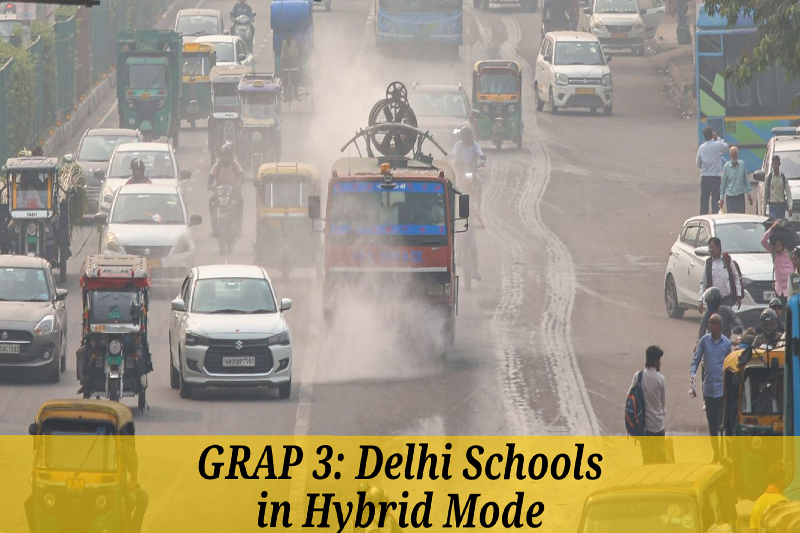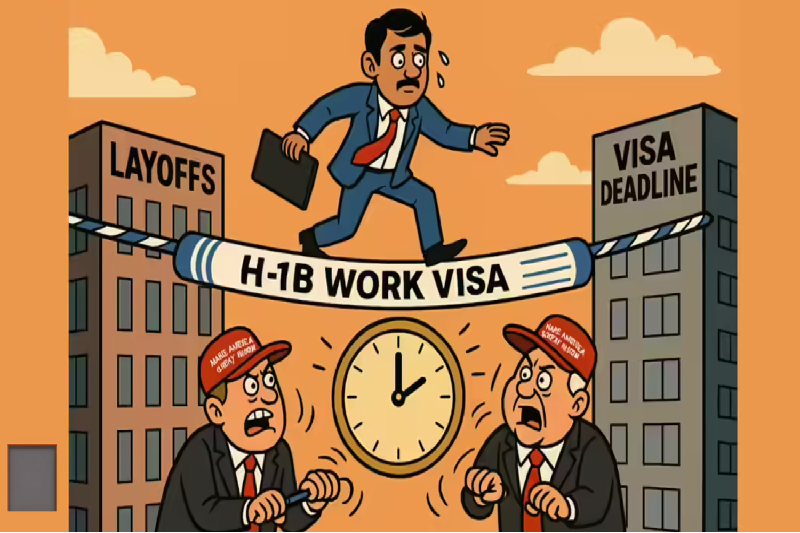
Delhi Schools Switch to Hybrid Mode as GRAP III Restrictions Enforced Amid ‘Severe’ Air Pollution
Introduction: A City Choking Under the Smog
Delhi’s air quality crisis has once again taken center stage as the national capital grapples with hazardous pollution levels. Following a sharp spike in the Air Quality Index (AQI), which touched a dangerous 425, the central government has enforced Stage III of the Graded Response Action Plan (GRAP). In response, the Delhi government has directed all schools to shift to hybrid mode for students up to Class 5 — giving parents the flexibility to choose online learning to protect their children from the toxic air.
This decision reflects growing health concerns for young learners, who are among the most vulnerable to prolonged exposure to severe air pollution. The situation underscores the urgent need for both policy intervention and public awareness as Delhi battles yet another pollution season.
Air Quality Worsens: Delhi’s AQI Crosses 400 Mark
The decision to activate GRAP Stage III came after the Commission for Air Quality Management (CAQM) reported a steep rise in Delhi’s AQI — from 362 on Monday to 425 on Tuesday morning. This jump officially pushed the capital’s air into the ‘severe’ category, where pollution levels are considered hazardous for all age groups.
Experts from the CAQM attributed this alarming spike to a combination of calm surface winds, a stable atmospheric layer, and weather patterns that have trapped pollutants close to the ground. These stagnant conditions have effectively turned Delhi’s air into a toxic blanket, preventing dispersion of fine particulate matter such as PM2.5 and PM10, which can penetrate deep into the lungs and bloodstream.
Hybrid Learning Returns: A Safety Measure for Students
In light of these developments, the Delhi government has directed schools to adopt a hybrid model of learning for students up to Class 5. This means parents can now opt for online classes to minimize their children’s exposure to outdoor air. Schools have been asked to stay vigilant, monitor air quality updates, and adjust their academic schedules accordingly.
While older students will continue attending in-person classes, institutions have been reminded to prioritize indoor air quality and avoid outdoor assemblies, sports, or events until conditions improve. Many schools have already resumed online modules, reactivating virtual classrooms to ensure that learning continuity is not compromised even as environmental safety becomes paramount.
Understanding GRAP Stage III: The City Under Restriction
The Graded Response Action Plan (GRAP) is a tiered framework designed to combat air pollution in Delhi-NCR based on the severity of air quality. Stage III represents one of the stricter levels, imposed when the AQI crosses 400. The enforcement of GRAP III brings with it a series of stringent restrictions aimed at curbing emissions and reducing dust and vehicular pollution.
Under Stage III, the following measures have been implemented across Delhi and adjoining NCR regions:
- Ban on non-essential construction and demolition activities to limit dust generation.
- Closure of stone crushers and mining operations, both of which significantly contribute to particulate matter in the air.
- Restrictions on the use of BS-III petrol and BS-IV diesel vehicles, except for emergency services and vehicles used by persons with disabilities.
- Suspension of specific industrial activities that rely on polluting fuels.
These measures are designed to bring immediate relief by cutting down on pollution sources that can be controlled in the short term. However, authorities emphasize that sustained improvement will depend on favorable weather conditions and long-term behavioral changes.
The Health Emergency: Who Is Most at Risk?
The worsening air quality poses serious health risks, particularly for children, the elderly, and individuals with pre-existing respiratory or cardiac conditions. Health experts warn that prolonged exposure to ‘severe’ AQI levels can cause respiratory inflammation, fatigue, reduced lung function, and even long-term neurological effects in children.
Given that students are among the most exposed demographic — spending significant time commuting and participating in school activities — the government’s hybrid learning directive aims to mitigate immediate health hazards. Schools have also been advised to install air purifiers in classrooms, limit physical activities, and maintain clean indoor environments.
Authorities have further urged residents to:
- Minimize outdoor exposure, especially during morning and evening hours when pollution is densest.
- Use N95 masks if stepping outdoors is unavoidable.
- Keep air purifiers operational indoors.
- Stay hydrated and include antioxidant-rich foods in their diet to reduce pollution-induced oxidative stress.
Experts Speak: A Wake-Up Call for Sustainable Action
Environmental experts view this situation as a recurring reminder of Delhi’s deep-rooted pollution problem. Every winter, the combination of crop residue burning, vehicle emissions, industrial pollutants, and weather stagnation creates an annual smog crisis.
According to pollution analysts, while emergency actions like GRAP III are necessary, they remain temporary solutions. The focus, they argue, should shift toward long-term systemic reforms — including public transport upgrades, sustainable urban planning, and stricter enforcement of emission standards.
Dr. Anumita Roychowdhury, a noted air quality expert, has emphasized that Delhi’s recurring air emergency highlights the lack of regional coordination and insufficient investment in green infrastructure. “Temporary shutdowns cannot be the solution every year,” she notes. “We need structural reforms that address the sources of pollution year-round.”
Government and Citizens: Shared Responsibility in Combating Pollution
Both the Delhi government and the Centre have reaffirmed their commitment to tackling the pollution crisis. The CAQM continues to monitor air quality trends closely and has left open the possibility of escalating restrictions to Stage IV — the “severe plus” category — if conditions deteriorate further.
Meanwhile, civic participation remains critical. Citizens are encouraged to carpool, use public transport, avoid open burning, and support local initiatives aimed at reducing carbon footprints. Schools and workplaces are also being urged to promote remote or hybrid work models to minimize vehicular emissions during peak pollution periods.
Conclusion: Education Continues Amid the Smog
As Delhi struggles under a thick haze, the shift to hybrid learning represents a necessary compromise — ensuring safety without halting education. The decision underscores the government’s adaptive approach in balancing public health with academic continuity.
While short-term measures like GRAP III can offer temporary relief, Delhi’s long-term recovery depends on sustained, collective action — from government policy to community-level behavior. Until then, hybrid learning and precautionary steps remain the city’s best defense against an invisible yet pervasive threat.



